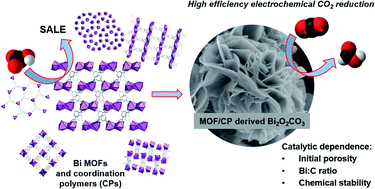Exploring the influence of atomic level structure, porosity, and stability of bismuth(iii) coordination polymers on electrocatalytic CO2 reduction†
Abstract
Bismuth-based coordination polymers (CPs) have recently attracted attention as catalyst precursors for the electrocatalytic CO2 reduction reaction (eCO2RR). We present a comparative study by investigating six bismuth-based compounds in-depth to elucidate the correlation between their structures and their catalytic CO2-to-formate conversion. Thereby, we identify structural indicators of the pristine CPs resulting in optimized catalytic performance, paving the way for future design of CP derived catalysts. The structural properties of the six pristine materials vary in terms of porosity (from non-porous to 495 m2 g−1), linker type (carboxylate- or phenolate-based), thermal- and chemical stability, and metal content. Herein, electrochemical studies are combined with comprehensive structural investigations using electron microscopy, powder X-ray diffraction, and X-ray absorption spectroscopy. Our study reveals that low chemical stability of the pristine CPs is crucial for the conversion of the precursors into active Bi2O2CO3 and of paramount importance for the eCO2RR activity, while the nature of the pristine material mostly influence the catalyst morphology and transport properties. Of the six investigated CPs, the best performing compounds selectively convert CO2 to formate with faradaic efficiencies in the range 80(3)–95(3)% and current densities of 5(1)–8(1) mA cm−2 at −0.97 VRHE.



 Please wait while we load your content...
Please wait while we load your content...